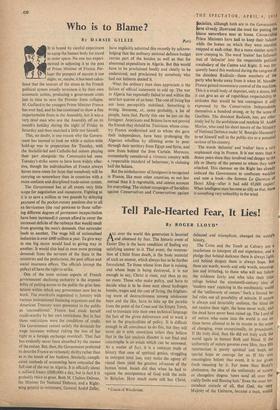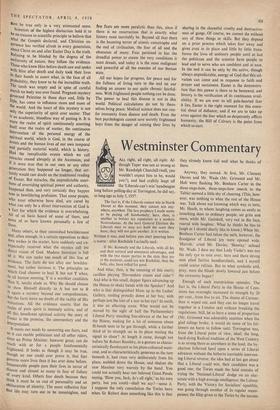Tell Pale-Hearted Fear, It Lies!
By ROGER LLOYD* ALL over the world this generation is haunted and obsessed by fear. The historic event of Easter Day is the basic condition of finding any satisfying answer to it. That event, the resurrec- tion of Christ from death, is the basic material of such an answer, which always has to be further formulated. To those whose lives fear is ruining, and whose hope is being destroyed, it is not enough to say, Christ is risen, and then to say no more. Those who make policy, and have to decide what is to be done next about hydrogen bombs, wages and the cost of living, the frighten- ing wave of destructiveness among adolescent boys and the like, have to take up the parable from the point of the Cross and the Empty Tomb, and to translate into their own technical language the fact of the given deliverance and to work it out in the practicalities of policy. It is difficult enough in all conscience to do this, but they will never do it with conviction unless they believe that in the last analysis disaster is not final and catastrophe is an estate which can be answered. As a matter of fact, it is a constant truth of history that men of spiritual genius, struggling to interpret total loss, may make the agony all round them yield the greatest advances of the human *mind. Isaiah did that when he had to square the omnipotence of God with the exile in Babylon. How much more still has Christ, * Canon of Winchester. defeated and triumphant, changed the world's history.
The Cross and the Tomb at Calvary are touchstone to interpret all our experience, and e pledge that behind darkness there is always light, and behind despair there is always hope. But these are words, words and only words, meaning- less and irritating, to those who will not follow the evidence fairly and who take their false refuge behind the nineteenth-century idea of 'modern man' rejoicing in the mechanistic world of the 'uniformity of nature.' Such a limited be- lief rules out all possibility of miracle. If nature is always and invariably uniform, the blind do not receive their sight, the lame never walk, and the dead have never been raised up. The Lord of all nature who came into the world is not on these terms allowed to be its master in the sense of changing, even exceptionally, its procedures. If He truly died, then He did not truly walk the world again in human flesh and blood. If the uniformity of nature governs even Him, then His resurrection is purely spiritual and holds no special hope or courage for us. If life was meaningless before that event, it is not given fresh meaning by it. Far more than Blake's abstinence, the idea of the uniformity of nature as changeless dogma 'sows sand all over the ruddy limbs and flaming hair.' Even the most tre- mendous miracle of all, that God, the very Majesty of the Universe, became a man, would then be true only in a very attenuated sense.
Scientists of the highest distinction hold it to be no treason to scientific principle to believe that What the Gospels declared, and Christian ex- perience has verified afresh in every generation, about Christ on and after Easter Day is the truth. Refusing to be blinded by the dogma of the uniformity of nature, they follow the evidence. Those who knew Him before death saw and spoke with Him after death and daily took their lives in their hands to assert what, in the face of all Probability, they knew to be the incredible truth. The tomb was empty and in spite of careful search no body was ever found: Pregnant mystery governed Palestine in those days and, little by little, has come to influence more and more of the world. And the heart of this mystery is not only the superiority of spirit over matter. That is an academic, bloodless way of putting it. It is More the realm of spirit continuously asserting itself over the realm of matter, the continuous intervention of the personal energy of the spiritual world, which is God, in the course of events and the human lives of our own temporal and partially material world, which is history. Had the inexplicable events which we call miracles ceased abruptly at the Ascension, and if it were true that in our own or any other generation they happened no longer, that cer- tainly would cast doubt on the traditional reading of Easter. But miracles, the unpredictable asser- tions of overriding spiritual power and authority, happened then, and very certainly they happen now in bewildering profusion. That some people, Who must otherwise have died, are cured by What can only be a direct intervention of God is a fact for which the evidence is overwhelming. MI of us have heard of some of them, and some of us have known personally a few of them.
Many others, to their astonished bewilderment and, often enough, in a certain opposition to their awn wishes in the matter, have suddenly and un- expectedly received what the mystics call tne direct vision of God. Modern literature is full of it We can make too much of this line of evidence. The facts do not allay our bewilder- ment, but rather increase it. The principles on which God chooses to heal X but not Y when, to all human seeming, Y is a worthier candidate than X, totally elude us. Why He should choose to show Himself directly to A but not to B is again a mystery beyond our comprehension, but the facts leave no doubt of the reality of His visitations. All the evidence asserts that the realm of pure spirit is intensely active, and of all this beneficent spiritual activity the story of Easter is the promise, the commentary and the interpretation.
It meets our needs by answering our fears, and so it can enable politicians and all other rulers, since no Prime Minister, however great, can do Much with or for a people fundamentally frightened. It looks as though it may be true, though no one could ever prove it, that fear 8overns more lives than it has ever done before. Innumerable people pass their lives in terror of disease and almost as many in fear of failure of every kind. Others fear death because they think it must be an end of personality and an obliteration of identity. The more reflective fear that life may turn, out to be meaningless, and few fears are more paralytic than this, since if there is no resurrection that is exactly what history must inevitably be. Beyond all that there is the haunting terror of atomic catastrophe and the end of civilisation, the fear of all and the obsession of many. Fear persisted in has the dreadful power to create the very conditions it most dreads, and today it is the most malignant and powerful of all the enemies of our human state.
All our hopes for progress, for peace and for the fullness of living turn in the end on our finding an answer to our quite chronic fearful- ness. With frightened people nothing can be done. The power to heal this disease is not in this world. Political calculations do not by them- selves bring peace. Medical science does not con- fer immunity from disease and death. Even the best psychologists cannot save secretly frightened boys from the danger of ruining their lives by sharing in the shameful cruelty and destructive- ness of gangs. Of course, we cannot do without any of these things or skills. But they depend on a prior process which takes fear away and gives trust in its place and little by little trans- forms the lives of ordinary people until at last the politician and the scientist have people to lead and to serve who are confident and at ease. In the end it can be only by the active, though always unpredictable, energy of God that 'this sal- vation can come and in response to faith and prayer and sacrament. Easter is the demonstra- tion.that this power is there to be bestowed, and history is the verification of its continuous avail- ability. If we are ever to tell pale-hearted fear it lies, Easter is the right moment for this essen- tial shout of defiance; and if we are to take up arms against the fear which so desperately afflicts humanity, the Hill of Calvary is the point from which to start.































 Previous page
Previous page